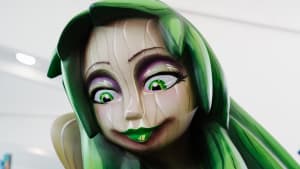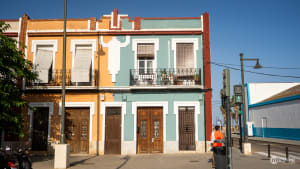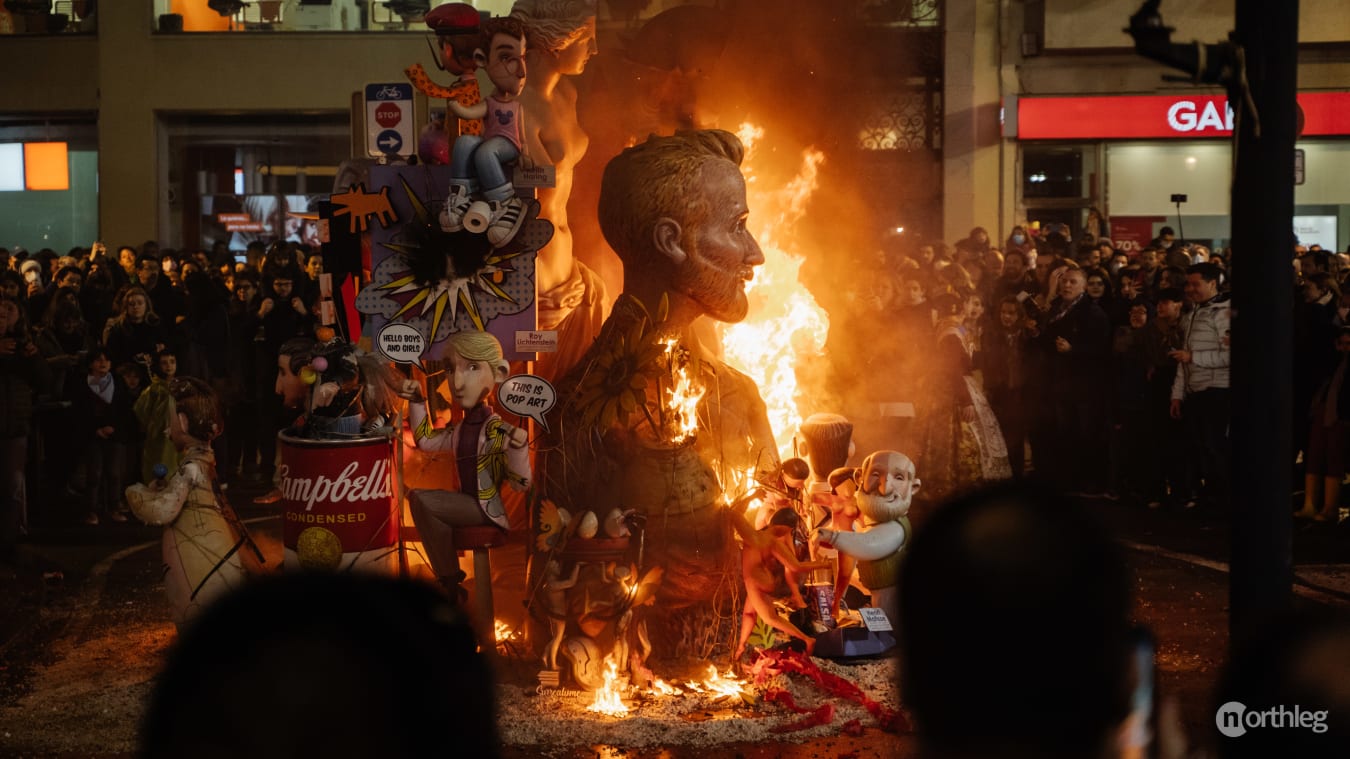
La Cremà
A night of bonfires, where almost 800 sculptures are fed to the flames. The Cremà is much more than the Fallas closing ceremony for the thousands of Valencians that watch it every year
La Cremà in a nutshell…
La Cremà is the dramatic conclusion of the Fallas festival, where nearly 800 sculptures are set ablaze across Valencia in a spectacular night of bonfires on March 19th.
Location: Throughout Valencia, with the final burning at Plaza del Ayuntamiento.
Time: Begins in the evening on March 19th, with the last falla burning past midnight.
Entry: Free to attend, but expect large crowds.
Main Attractions: Massive papier-mâché sculptures, fireworks, and the final burning of the municipal falla.
The Nit de la Cremà (Night of the Cremà) is, undoubtedly, the highlight of the Fallas festival. It is the event that fills the streets of Valencia with millions of visitors from all over the world.
On the 19th of March, they are all eagerly waiting to see the burning of the fallas, the allegorical papier-mâché and wooden sculptures that make the festival so recognisable.

For a year, artists, committees, and the community at large invest their energy and time in the making of thefallas. This is the concluding event that elevates all their hard work to a symbolic level.
On Saint Joseph’s day, as the night falls on Valencia, the streets buzz with anticipation. The people know that soon all the colourful figures and sculptures that tower in the city’s squares will be burnt in huge bonfires.
In the crackling flames and showering fireworks, one year is laid to rest, while from the embers, another one is born. The Cremà is a homage to renewal and to spring itself. It is the final, cathartic act that concludes the crescendo of celebrations, music, and pyrotechnic shows. The burning of the fallas, bound to end up in ashes from the start, is an inevitable end and beginning, written into the very fabric of the festival.
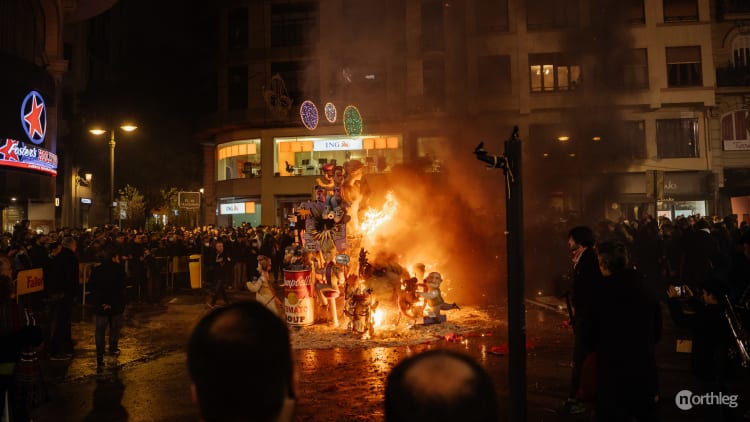
The event is broadcast live on national tv and even internationally. So, if you’re lucky enough to be in Valencia during the final days of the Fallas festival, you must go and watch the burning of these stunning art pieces.
As the heat of the fire warms up the last of the winter air, the roaring flames will shine in the hundreds of eyes set on the scene, while up above, the smoke fills and darkens the sky.
What It is Exactly
Cremà is the term used to refer to the burning of all the fallas sculptures. This series of massive bonfires is one of the most important rituals in the Fallas festival. It marks its last, concluding night, the 19th of March.
Despite its importance and fame, the Cremà is also one of the most misunderstood acts of the festival by non-Valencians.
Many ask, how is it possible that an entire year of fundraising, dedicated holidays, hard work, and a final twenty days of celebration, all go up in flames? But in reality, the Cremà is the raison d’être of the whole Fallas festival, its end and its beginning.
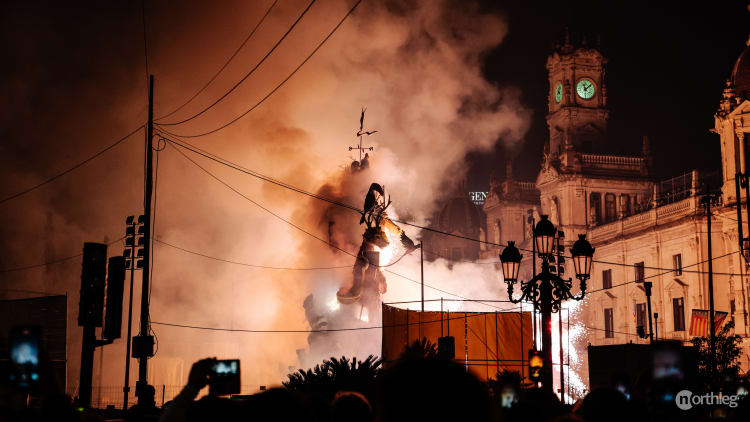
The Cremà is a fire ritual, where the flames bring renewal, where all that is old is destroyed to make way for the new, a rebirth of the city. The word comes from the Latin crematio, which literally means “the act of burning”. And it is in these roaring flames that the fallas that involved a whole community go.
If you have any doubts regarding some terms or words that relate to Fallas, you can check out our article with a complete Fallas vocabulary.
The Burning
First of all, you have to keep in mind that this is the whole point of a sculpture’s existence, so in a way the Cremà begins in the artists’ workshops. The fallas are designed specifically to burn a certain way. After that, the procedure for burning them is pretty much the same, regardless of size.
After the sculptures are placed in their final position and all their parts added, pyrotechnic materials and tracas (wicks lined with firecrackers) are placed in strategic points. This is so that, when the falla is lit on fire from the top, these materials are ignited, producing a mesmerising (and very loud) spectacle.
Which Fallas are Burnt
Not everything is fed to the flames on the night of the Cremà. Some figures are saved every year.
Before the end of the festival, a ninots exhibition is organised. Each committee choses two puppets (one for children, one for adults) which, according to them, best represent the fallas of which they are part.
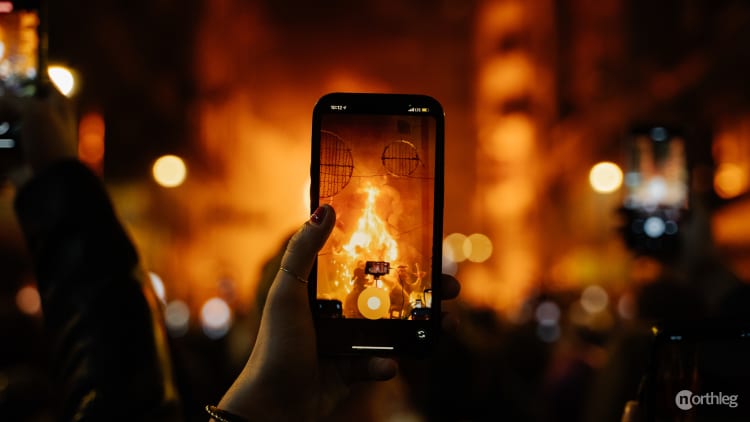
The exhibition’s visitors vote, and the winning ninots are pardoned from the fire, becoming ninots indultats. You can visit all the pardonedninots (since 1934) in the Museo Fallero. All other puppets are taken back to their respective fallas after the exhibition, and will be burnt with them.
The Music
The Cremà is a very important, symbolic moment that moves the participants: the end of the old cycle and the beginning of a new one. With the start of each fire, traditional folk songs are played and even sung by the public.
When the municipal falla in Plaza del Ayuntamiento is burnt, bringing the festival to a closure, the regional anthem is played via the loudspeakers and sung by everyone in the square. This is a further expression of the strong regional identity that characterises the Valencian people and that permeates the festival as a whole.
Schedule
Every year, on the night of Saint Joseph’s day ( 19th March ), the Cremà is celebrated with the burning of all the sculptures. In the flames, one entire year of preparation reaches its climax and is concluded.
As for the timetable, it changes slightly every year and it is not generally closely followed, as is to be expected with such big events. It roughly follows the same structure every year.
- Fireworks – To mark the beginning of the burning ceremony, the Fallera Mayor lights fireworks, and the burning of the children’s fallas can begin.
- Cremà of the fallas infantiles – This usually begins at around 8:00 or 10:00 pm.
- Cremà first prize (infantiles) – After other fallas infantiles are burnt, the special section’s first prize winner in this category is burnt too. According to the official timetable, this should take place half an hour after the burning of the initial falla infantil.
- Cremà of the adult fallas – After the children’s celebration, the adult fallas, sometimes called fallas mayores, are burnt. According to the official timetable, this is two hours after the initial falla infantil has been burnt.
- Cremà first prize (adult fallas) – Following the same logic as before, the special section’s first prize winner for the adult fallas is burnt after 30 minutes.
- Municipal Cremà – Finally, after all other fallas have been burnt, the municipal falla in Plaza del Ayuntamiento is burnt too, bringing the festival to a closure.
This timetable generally allows for people to see as many fallas as possible. What many locals do is to go see their neighbourhood falla burn, then the first prize winner, and the municipal falla for last.
If you’d like to know more details about the full Fallas calendar, you can have a look at our article about it.
Location and Map
There are just under 400 fallas committees in Valencia. Considering that each committee produces two fallas (one for kids and one for adults), this means that on the night of the Cremà, there are almost 800 fallas burning around the city: several per neighbourhood.
Although every year an app with the fallas map is released so you can take a look online.
In any case, as a general rule, the sculptures are placed wherever there’s enough room to host them. Squares, broad street corners, and even wide enough streets are all good spots.

Since the sculptures are not lit on fire until there’s a firefighter team on-site, our tip is to follow them. If, when walking around the city on the night of the 19th of March, you see a fire brigade by a falla, that is a good sign the sculpture is going to be burnt up soon.
A spot where you’re sure to find a falla –the biggest one, in fact– is Plaza del Ayuntamiento. Here is the municipal falla, the last one to be burnt, which concludes a cycle of fallas festivities and begins the next one.
Curiosities
Did you know that there’s a right and a wrong way in which the fallas can burn on the night of the Cremà? And what about the ancient origins of this ritual? In this section, you can find out all the most interesting facts about the Cremà.
The Origins
There are two main theories regarding the origins of the Cremà, and the Fallas festival in general.
The first one is common to many other seasonal festivities in the Christian world. According to this theory, the festival can trace its origins back to the time when rituals were habitually performed on the occasion of seasonal changes (winter to spring, spring to summer, etc…).
The Catholic church, unable to eliminate (or perhaps cunningly rebranding) the ritual, embraced it as a celebration related to St Joseph (San José, in Spanish). This day, as it just so happens, falls basically on the day of the spring equinox.
Another theory sees the ritual as a direct descendant of the carpenters’ celebration of their patron saint (St Joseph indeed). Tradition dictates that, during the winter and autumn months, Valencian carpenters used to illuminate their workshops with a parot, a sort of chandelier supported by a wooden pole.
When days were becoming longer, and St Joseph’s day came around, the carpenters would put the parots in the street, together with unused scraps of wood, and burn them to celebrate.
Over time, the bonfires became richer and the poles more elaborate, to the point that they were given human appearances and started being a way to mock disliked figures or people.
Keep the Flowers Safe
The fallas are placed in almost every square of the city, and sometimes, where there’s no square, at street crossings, corners, or just where the street is wide enough to allow for the sculpture to be placed.
In these cases, the structures are in close proximity to monuments, buildings, and houses. This forces the fire brigades to prep the site for the burning of the fallas: just before the sculptures are lit, they cut off the electricity and dampen the nearby walls, trees, and flowers on the balconies to prevent damage.
Don’t Rely on the Timetable Too Much
Although there’s an official programme that defines at what time every event is going to take place every year, many fallas don’t actually burn at the officially reported time.
This is because firefighter presence and clearance are required at every site where a sculpture is burning. Since there simply aren’t enough firefighter teams to oversee the burning of almost 400 fallas at the same time, the burning goes on for many hours.
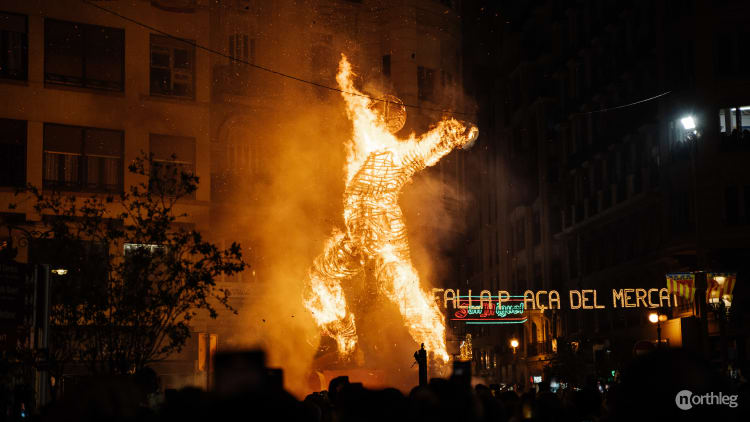
This is also advantageous for the public because it means it’s possible to witness several fallas burn throughout the night.
You might want to take a look at the Fallas calendar.
The Right Way to Burn
The Fallas aficionados - that is to say almost every Valencian person - know that there’s a specific way the sculptures should burn. For this reason, during the Cremà, particular attention is paid to where and how the fallas burn and fall on themselves.
According to the experts, in a well-built falla, when the highest part of the statue is burnt (generally the central section), it should always fall perpendicularly to the ground, and never sideways. Falling apart and to the sides is, apparently, a sign of poor construction and poor burning practices. As such, it would provoke criticism from the committees and the public.
Frequently Asked Questions
Here you can find quick answers to all of your questions. Linked, you’ll find the articles or the sections of the articles that can give you more detailed information.
-
The word Cremà comes from the Latin crematio, which literally means “the act of burning”. It is the final event of the Fallas festival, when the falla sculptures are burnt.
-
No, the Cremà is the concluding event of the whole Fallas festival. After that, the only thing left to do is to start planning next year’s Fallas.
-
The Cremà is what the whole Fallas festival is geared towards. It is the concluding and most spectacular event, in which the falla sculptures are burnt in massive bonfires around the city.
-
During the Cremà all the falla sculptures are burnt. These allegorical sculptures are made of papier-mâché and wood, so that they can easily catch fire.
-
The burning of the fallas is the whole point of the Fallas festival. This bonfire event has ancient origins, but its meaning has remained more or less unchanged: it signifies renewal, the end of one year and the beginning of a new one.
-
Yes, all fallas are burnt in La Cremà. However, two ninots (figures that are part of a bigger falla) are pardoned by popular vote every year.
-
The ninots are the individual figures (or puppets) that make up a falla. A falla usually represents a big, dynamic scene. The bigger fallas can be made up of dozens of ninots.
-
Every year, a ninot is taken from each falla and shown at an exhibition. The public then votes on which ninots they think should be saved. The two winning ninots (one of the adult fallas and one for the children’s fallas) become ninots indultats.
-
When the municipal falla (the biggest and last one) is burnt in Plaza del Ayuntamiento, the regional and national anthems are played via the loudspeakers and sung by everyone in the square.
-
The Cremà timetable can vary in terms of time (it will usually begin between 8:00 pm and 10:00 pm). The order of the events, on the other hand, remains the same every year.
-
First, the children’s fallas are burnt.
-
The last of the children’s fallas to be burnt is the first prize winner for that category.
-
Then, the adult fallas are burnt.
-
Then, the first prize winner for the adult fallas is burnt.
-
Lastly, the falla in Plaza del Ayuntamiento is burnt.
If you’d like to know more about the schedule, you can check the relevant section of this article.
-
-
Although the name La Cremà might lead you to think it is one single event, many Cremàs take place in different parts of the city, for several hours. Everywhere there’s a falla sculpture there will be a Cremà at some point.
The last Cremà always takes place in Plaza del Ayuntamiento.
If you’d like to know more about the specific locations and the map, you can have a look at the relevant section of this article.
-
Yes, because there is a map of all the falla sculptures in the city.
If you’d like to know more about this map, you can have a look at the relevant section of this article.
-
In general, no. There are many measures in place to make the event as safe as possible, and the burning cannot start until firefighters have cleared the site and are ready to intervene.
That said, you should always be careful and never go past the fences.
If you want to know more about safety during the event, check out our article on it.
-
Absolutely yes. Firefighters have to be present to oversee the burning and secure/prepare the site before the Cremà of a sculpture even begins.
This is actually one of the reasons why the different Cremàs don’t all take place at the same time: to allow firefighters to move from one location to the other.
-
The biggest and most famous falla is always located in Plaza del Ayuntamiento. It is known as falla municipal and it is always the last one to burn.
-
There is a vast Fallas vocabulary, but you can understand what is going on by learning a few keywords.
You can learn all the vocabulary you need to get by in our article about it.
-
There are two theories about the Cremà’s origins.
The first one is that the festivity is a descendant of pre-Christian spring bonfires.
According to the second one, carpenters in the city used to celebrate the end of winter and their patron saint (Saint Joseph) by burning unused wood outside their workshops. Supposedly, this later evolved into the event we know today.
To know more about these two theories, you can check the relevant section of our article.
-
Firefighters prepare every location for the burning of a falla. Just before the fire is lit, they make sure to cut the electricity and dampen the nearby walls, trees, and plants. If needed, during the fire they continue to keep the nearby plants and windows wet.
You can read more about this in the relevant section of this article.
-
Not much. It is good to have an idea of when the events should be taking place, but will likely not be respected.
If, for example, the timetable says that the adult fallas will start burning at 8:00 pm, you might not see one burn until 9:45 pm.
This is because safety concerns (like having enough firefighters and securing the location) are regarded above everything else.
-
Yes, the falla sculptures are built and lit on fire so that they can burn in a very specific way.
In a well-built falla, the highest part of the statue should burn first and fall straight down to the ground, never sideways. And Valencians know this too, so they always pay attention to the way the sculptures burn.
To know more about this, you can check the relevant section of this article.



